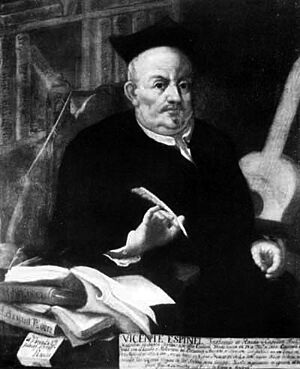Vicente Espinel facts for kids
Vicente Espinel (born December 28, 1550 – died February 4, 1624) was a Spanish writer and musician. He lived during a special time in Spain called the Siglo de Oro, which means "Golden Age."
He is famous for creating a new type of poem called the décima. This poem has ten lines, and each line has eight syllables. It is also known as the espinela because it was named after him.
Contents
About Vicente Espinel
Early Life and Studies
Vicente Espinel was born in a city called Ronda in Spain. He went to college at the University of Salamanca. There, he started using his father's second last name, Espinel, as his own. He also studied at other universities, like Granada and Alcalá.
Espinel was very good at Latin. He even translated a famous Latin poem by Horace into Spanish. This poem was called Epistola ad Pisones.
An Adventurous Life
After college, Espinel had many exciting adventures. He became a soldier and fought in places like Flanders. He was even captured by pirates and held prisoner in Argel.
After he was freed, he continued as a soldier in Italy. Around 1584, he returned to Spain.
Life in Madrid and Music
Later, Espinel moved to Madrid. In 1589, he became a priest. A few years later, he became a chaplain in his hometown of Ronda.
Espinel was also a very talented musician. Because of his musical skills, he became the choirmaster in a city called Plasencia.
His Writings
In 1591, Espinel published a book of poems called Diversas Rimas (Assorted Rhymes). These poems showed his clever and sometimes funny way with words.
His most famous book is a novel published in 1618. It is called Relaciones de la vida del escudero Marcos de Obregón. This book tells a story about a squire, Marcos de Obregón. It includes many details from Espinel's own life. This book was so popular that it was printed in France the same year. It even inspired another famous book called Gil Blas de Santillana by Lesage.
Espinel also helped bring back the ten-line poem style called décimas or espinelas. These poems have ten lines, and each line has eight syllables.
Friends and Legacy
Vicente Espinel had many famous friends. One of them was Lope de Vega, a very important Spanish writer. Lope de Vega even called Espinel his teacher. He dedicated one of his plays, El caballero de Illescas (1602), to Espinel.
Espinel was also friends with Miguel de Cervantes, who wrote Don Quixote. He was also close with Luis de Góngora and Francisco de Quevedo, two other well-known poets. Espinel even helped Góngora publish some of his poems.
Like his friends, Espinel was part of a religious group called Esclavos del Santísimo Sacramento. When he passed away, he was still a chaplain in Madrid. He was also the music teacher for the bishop of Plasencia.
Today, you can find a statue of Espinel in Ronda, his hometown. It is in a small square called Plaza de los Gigantes. The statue shows his head decorated with a laurel wreath, a symbol of honor.
See also
 In Spanish: Vicente Espinel para niños
In Spanish: Vicente Espinel para niños


